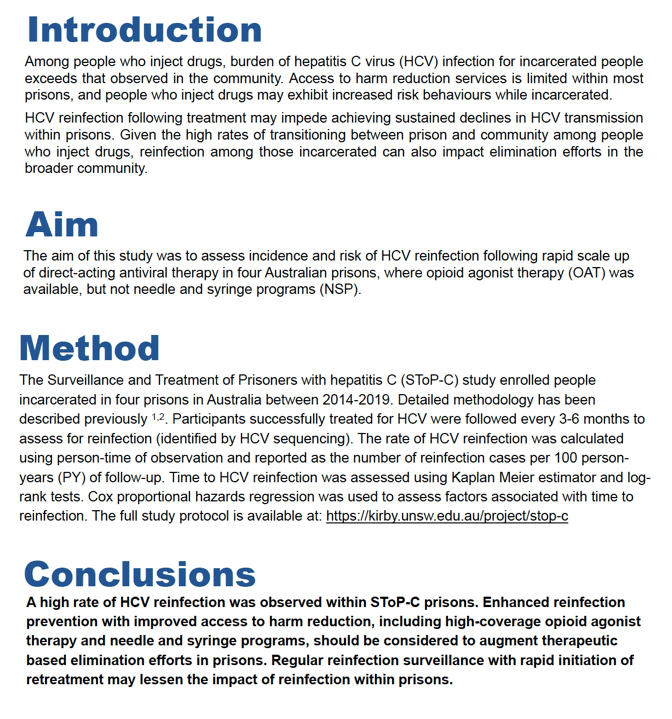 |
 |
 |
| |
Hepatitis C virus reinfection [high] following direct acting
antiviral treatment in the prison setting: the SToP-C study
|
| |
| |
EASL @022 June 22-26 London
For more details about this study, please read the full article in: Carson JM et al. Clinical Infectious Diseases. 2022
(https://doi.org/10.1093/cid/ciac246)
The large majority of participants with IDU in prison (90%) reported needle/syringe sharing compared to 16% among people accessing NSPs in community settings in Australia [15]. These data indicate that improved access to harm reduction services within prisons is needed, including access to long-acting injectable OAT with minimal risk of diversion [19]. However, of note, those injecting opioids less frequently may not be eligible for OAT and it is unlikely to benefit those injecting mostly methamphetamine (20% in this study). All participants retreated for reinfection with posttreatment assessment achieved SVR12. It is consistent with findings from a real-world cohort of people with HCV reinfection retreated through a diverse range of settings, including prisons [27].
In conclusion, this study identified a high rate of reinfection following HCV treatment among an incarcerated population with limited access to harm reduction services. Enhanced reinfection prevention, including high-coverage OAT and access to NSPs, should be considered to augment therapy-based elimination efforts in prisons. Regular reinfection surveillance, particularly during the first 6 months posttreatment, with rapid initiation of retreatment may lessen the impact of reinfection within prisons.
This study assessed HCV reinfection following DAA treatment in 4 Australian prisons that had OAT programs but did not have NSPs. A relatively high posttreatment reinfection incidence was observed among participants, with increased risk among those with recent IDU and needle/syringe sharing. These findings highlight the need for posttreatment surveillance to detect and retreat reinfection early and support enhanced access to harm reduction services, including increased coverage of OAT and the implementation of NSPs within prisons.
In this study, an HCV reinfection incidence of 12.5/100 PY was observed among incarcerated people. In comparison, reinfection incidence in an international study of people with recent IDU in community was 6/100 PY, whereas population-level reinfection incidence among people with a history of IDU in Scotland was 4/100 PY [11, 12]. In our study, reinfection incidence was highest at 3-6 months posttreatment, then decreased over time. Our data also indicated that longer posttreatment HCV testing intervals were associated with decreased likelihood of reinfection detection. It is explained by undetected cases of reinfection that spontaneously clear between visits [9, 13]. These findings suggest that more frequent HCV testing is required, particularly during the first 6 months posttreatment......some reinfection cases may have cleared spontaneously between follow-up visits and remained undetected. As such, the true posttreatment reinfection incidence among the prison population may be even higher than reported in this analysis.
----------------------
Carson JM1, Dore GD1, Lloyd AR1, Grebely J1, Byrne M1, Cunningham E1, Amin J2, Vickerman P3, Martin NK4, Treloar C5, Martinello M1, Matthews GV1, Hajarizadeh B1
1The Kirby Institute, UNSW Sydney, Sydney, Australia
2Faculty of Medicine and Health Sciences, Macquarie University, Sydney, Australia
3Population Health Sciences, University of Bristol, Bristol, UK
4Division of Infectious Diseases & Global Public Health, University of California San Diego, San Diego, USA 5Centre for Social Research in Health, UNSW Sydney, Sydney, Australia




|
| |
|
 |
 |
|
|